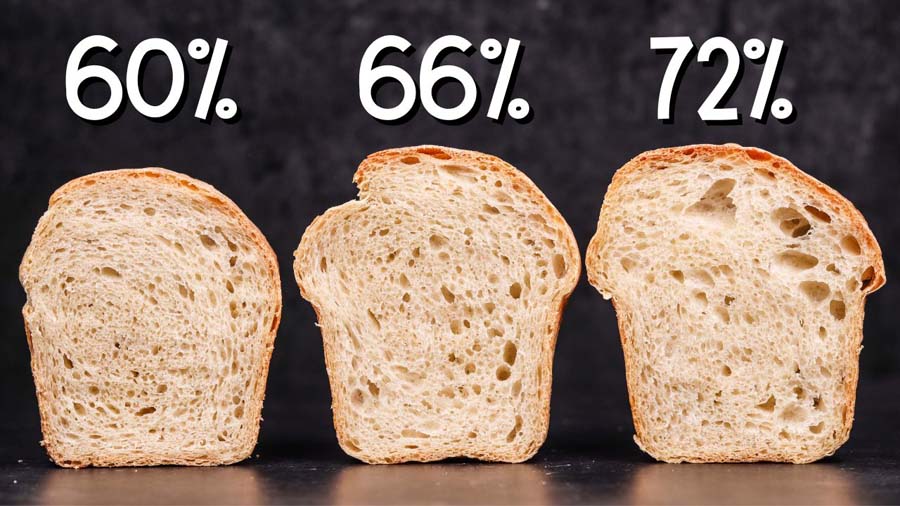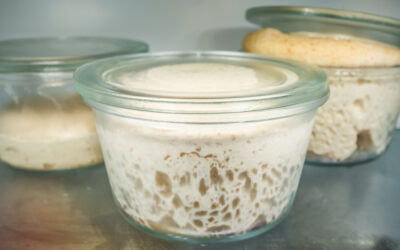Baker’s percentage is a universal language that bakers use for reading, writing, adjusting, and sharing recipe formulas. Knowing how to read it gives us the ability to instantly recognize the basic characteristics of the bread which is made using that specific formula. It is an incredibly simple concept. Every ingredient is calculated as a percentage in relation to the total amount of flour. No matter how much flour is used in the recipe, the amount of flour will always be 100%.
Dough hydration and baker’s percentage are intertwined. Hydration is the measure of water content in a bread dough recipe which is also expressed as a percentage. Bakers often describe breads mentioning the hydration percentage as one of the main attributes. The hydration level depends on the desired final product. Chewy bagels could be made with as little as 50% hydration while a light and airy high hydration ciabatta could go up to 100% or even more. Water content has some of the greatest effects on bread dough, so it must be considered well before a recipe is written and executed.
Almost every recipe will also contain yeast. Yeast comes in various forms from active dry yeast, which ironically must be activated before use; instant dry yeast which is-as the name suggests-instant, so it does not need activation; fresh yeast, which comes as a crumbly moist block; and sourdough leaven, which contains wild yeasts and bacteria. The commercial yeasts vary in strength, so their respective percentages can differ, but generally yeast is used in small quantities from around 0.5% for the dry ones and up to 4% for the fresh. However, a sourdough leaven would make up a much larger portion of dough at 20% or even higher.
Salt is another essential ingredient which brings out the flavour in our bread. It has other functions too like slowing down fermentation and tightening the gluten structure of the dough. The salt percentage varies from as little as 1% to as much as 2.5% or more depending on the dough production requirements, the taste of the baker, and the other ingredients contained in the dough, which may suppress the flavour of the bread.
A few simple formulas allow us to calculate any and every ingredient in a bread dough recipe. Almost every recipe contains more flour than any other ingredient; and when writing a new recipe or reading a recipe in a book, flour will always be at the top of the ingredients list. Here’s an example recipe with 500g flour, 70% hydration, 1% yeast, and 2% salt. To calculate the amount of water we simply multiply the amount of flour by 70% (500×70%) which results in 350g of water. The same applies to every other ingredient. (500×0.01) is 5g of yeast. (500×0.02) is 10g of salt.
Calculating the baker’s percentage values of a recipe which only has the amounts listed by weight is also straightforward. We already know that the flour is 100% because that’s the rule. To calculate the other ingredients, we must divide the specific ingredient weight by the weight of the flour. In a recipe with 500g flour, 325g water, 7g yeast, and 9g salt, if we want to find out the hydration percentage we must divide the amount of water by the amount of flour. (325:500) makes it a 65% hydration dough. (7:500) which is 1.4% yeast, and (9:500) which is 1.8% salt.
Writing your next recipe could be as simple as thinking of some percentages, calculating the quantities, weighing out the ingredients, mixing them together, and making a loaf of bread. But it may not always be the best approach if you are not sure of how large the loaf may turn out depending on how much flour you have appointed it. You may encounter an issue of the dough overfilling a banneton or a baking tin. Or you may not end up with the correct number of breads that you were planning on getting from that dough. Fortunately, baker’s percentage has another set of formulas that help us in creating exact recipes.
Let’s say we want to make 10 buns each weighing 150g. We have decided on a hydration level of 63%, yeast content of 1%, and salt content of 2%, and of course we know that the flour will be 100%. Multiplying the number of buns by the weight (10×150) tells us that the total amount of dough will be 1500g. Adding up the baker’s percentages (63+1+2+100) tells us the total percentage number which is 166.
Divide the total weight by the total percentage to calculate the mass of a single percent. (1500:166=9.036…) One percent equals about 9 grams. Rounding the numbers will result in a much neater and easier to read recipe. We can calculate the weight of every ingredient once we know the weight of a single percent. It only makes sense to start with the flour since it is a nice round number: 100×9=900. We can continue by multiplying each ingredient’s percentage by 9 or we can multiply the amount of flour by each percentage to calculate the weight of every remaining ingredient. 63×9=567 (567g water); 1×9=9 (9g yeast); 2×9=18 (18g salt). Adding up all the ingredients (900+567+1+2) results in a total of 1494g. We lost a few grams due to rounding.
Other recipes contain liquid fats such as oils or solid fats such as lard, butter or margarine. Eggs are often used in various forms from whole to yolk or just the white. Sweeteners such as granulated sugars, honey, treacle or maple syrup. And milk products ranging from low fat to full fat milk, yogurt, buttermilk or sour cream. Just as with water, yeast, and salt, every other ingredient is calculated separately to make up the total formula.
Unlike the basic dough ingredients, additives can contain various amounts of water. Oils are 100% fat while butter and margarine can contain up to 20% water. Whole eggs have a 75% water and 9% fat content. Egg yolks are 50% water and 30% fat. Egg whites are 90% water and 0% fat. Granulated sugar is 100% sugar, but honey and treacle contain around 20% water while the runny maple syrup can contain up to 30% water. Low fat milk can be close to 0% fat while full fat can get up to 3.5%. Yogurt can also be as low as 0% and as high as 5%. Buttermilk is pretty lean at 0.5% fat. Both milk and buttermilk are 90% water. Sour cream can range from 15% – 25% fat and have a water content of around 75%.
It is not always necessary to consider the fat and water content of each ingredient especially if it is only used in small quantities. A 15g portion of butter, for example, is insignificant in a dough made with 500g flour. Spending time calculating the water content of the butter and then adding it to the total hydration of the dough would be fruitless exercise in my opinion.
In other cases, however, it is useful to do the extra calculations. In high fat bread recipes such as brioche-which are made with up to 40% butter and where all the liquid is in the form of eggs-it is important to break down the individual ingredients to extract the accurate hydration and fat percentages.
Knowing the effects of each ingredient is also important in figuring out how much of it should be used and where it is most appropriate. Fat has a softening effect on dough. It weakens the gluten structure making the dough more stretchy and allowing it to rise better as it ferments and bakes. Knowing this we could assume that substituting full fat yogurt for low fat milk may result in a softer bread, but that would not be the case. Yogurt is acidic, and acidity has a tightening effect on gluten. Even though it contains more fat than milk, the resulting bread would have less volume, and it would be chewier. Of course, we can control the result by adjusting the amount of yogurt. Simply by using more of it we can make the bread softer and lighter.
There is much more to learn about breadmaking. We can only take it step by step. Experiment with your recipes, try something new, fail, learn, repeat. You can find videos about every ingredient and its effects on breadmaking in the Principles of Baking playlist on my channel.



